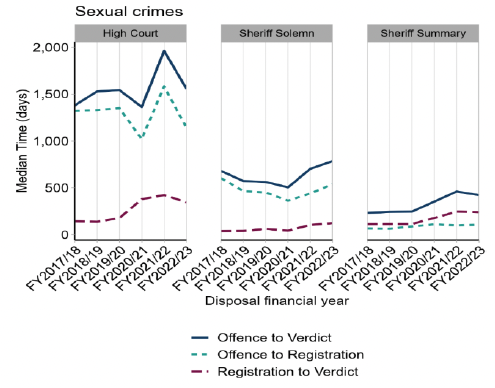Justice Analytical Services (JAS) Safer Communities and Justice Statistics Monthly Data Report: June 2023 edition
This report contains summary statistics covering a number of important justice and safer communities statistics. It is published with up to date statistics every month.
This document is part of a collection
Topic Pages
Scottish Prison Population Modelling
A full report on the projected prison population up to the end of September 2023 was published on 1st June 2023. It included the first projections to be published since the Covid‑19 pandemic began, and the primary aim was to help with decision making, planning, and policy development.
Forward projections from April to September 2023 were produced using 'microsimulation' scenario modelling which simulates prison arrivals and departures to help estimate the number of individuals in prison on a particular date in the future. This modelling performs well, when using accurate assumptions, but there is nevertheless uncertainty in the projections which increases with time. These projections provide a range of possible scenarios in which the population varies from roughly flat over the coming months to increasing to over 8,000 in September 2023.
Future prison population estimates
The chart shows the latest prison population projections for April 2023 to September 2023. It includes 50%, 75% and 95% confidence intervals for central, high and low court conclusions. The actual population is shown as a series of black points up to April 2023.
The above projections to September 2023 indicate that:
- The overall prison population in Scotland is highly likely to either remain stable or rise between April and September 2023, with a projected range of between 7,300 and 8,050 for the average daily prison population in September 2023. As at 1st May 2023, the prison population was around 7,600.
- It is likely that the remand population will remain stable, but it may decrease, between April and September 2023. If it decreases, this may increase the sentenced population, as individuals transition from remand.
- It is highly likely that the sentenced population will either remain stable or rise; it may rise if the overall rate of transition from remand to the sentenced population increases, or if there is a greater inflow of individuals directly from the community into the sentenced population (whilst the departures from the prison population remain stable).

Summary statistics on journey times in the Scottish criminal justice system
COVID-19 impacted journey times in the Scottish Criminal Justice system. Before the COVID-19 pandemic (up to and including 2019-20), 90% of accused reported to COPFS which were not marked for prosecution in court had their cases closed within one year of the offence being committed. This fell to 81% in the years during and following the pandemic. The same happened for accused prosecuted in criminal courts. During the pre COVID-19 period, 84% of accused proceeded against in criminal courts had a disposal issued within one year of the offence being committed. However, since the beginning of the COVID-19 pandemic this percentage has decreased to 61%.
Median journey times (from offence date to case closed) for cases closed by COPFS increased post pandemic and were longer for accused marked as "No Action". In 2022-23, median journey times for accused persons with a COPFS "No action" marking were around 11 weeks longer than for accused persons marked for direct measures (e.g. a warning letter or a fiscal fine).

Median journey times for accused prosecuted by courts (offence date to verdict) increased post pandemic. Across all court types, median journey times of accused persons increased in 2021-22 (post pandemic) when compared to 2019-20 (pre pandemic). Furthermore, except for Justice of the Peace (JP) courts, all other court types saw an additional increase in median journey times over the latest financial year 2022-23. Median journey times for accused persons in solemn cases were longer than those for accused in summary cases.

The time associated with different parts of an accused person's journey in the justice system varies depending on the type of court their case is allocated to. Median offence to registration time for accused persons in the high court were around 21 months and median registration to verdict times were 11 months; offence to registration time in sheriff solemn court were around ten months compared to four months for registration to verdict. In contrast, for sheriff summary court, registration to verdict times are, in general, longer than offence to registration times - median offence to registration journey times were around two months compared to a median of about six months for registration to verdict.

There were differences in accused persons' journey times depending on the type of crime on registration. The longest journey times were observed for accused persons charged with at least one sexual crime and prosecuted in high court – with a median time of around 4 years in 2022-23.

Further detail on journey times. More information about journey times including by crime types and accused with non-appearance warrants can be found in Journey times in the Scottish Criminal Justice System publication.
Contact
Email: Justice_Analysts@gov.scot
There is a problem
Thanks for your feedback